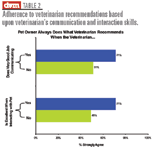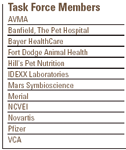Pet owner study: Communication key driver to improved animal care
National Report –– Communication is key to understanding animal-owner bonds, creating strong veterinary-client relationships and best ensuring proper care for pets, according to a recent study.
NATIONAL REPORT –– Communication is key to understanding animal-owner bonds, creating strong veterinary-client relationships and best ensuring proper care for pets, according to a recent study.

Table 1: Examples of pet owner actions that demonstrate bonding with their pets.
The 2006 Pet Owner Price Sensitivity and Attitude Study, facilitated by a 12-group collaboration and administered by BNResearch, shows owners are willing to pay for their pet's care when they have a strong relationship with their veterinarian and fully understand the benefits of care.
"The initial principal of the study was to understand in a more detailed way the pricing opportunity and what people felt about pricing and what people would or wouldn't pay for certain services. And it became much broader as we went along," says Howard Rubin, CEO of NCVEI.
"What became really powerful from this study is the importance of communication. It is important for clients to understand recommendations, while also making sure the veterinarians are demonstrating the value."

Table 2: Adherence to veterinarian recommendations based upon veterinarian's communication and interaction skills.
Based on 2,000 national phone surveys of households with dogs or cats and an online survey with 755 of the phone survey participants, the study reveals that the level of care provided to an animal is forged by the strength of the owner/pet bond.
"Various types of pet owners have different strengths of bonds with their pets and that can impact their decisions with veterinary care. If a veterinarian understands each owner's bond with a pet, veterinarians can interact in a way to increase the chances of them following recommendations for care," says Laura Neidhart, BNResearch president. Veterinarians learn these bonds by asking key questions during visits and maintaining responses in patient records.
Veterinarians must also foster their own bonds with owners, which translates to improved pet health and economic benefits. The study says that owners are more likely to heed recommendations for their pet when the veterinarian communicates effectively about the rationale for medical recommendations and the value for both pet and owner.

Table 3: Pet owners spend three times more money to acquire dogs than cats
"We are not talking about turning every veterinarian into a communicator like Winston Churchill or one of the great teachers on the planet. But rather, there are some basic techniques that can be used by veterinarians to deliver this information effectively," Rubin says.
The study also stresses the importance of communication to help even levels of veterinary care received between dogs and cats. Currently, the number of cats as pets is on the rise, but feline veterinary costs are down because cats are not receiving the same level of care, Neidhart says. Underpinning this discrepancy is attributed to how the animals are acquired in the first place, which is typically very different. Nearly half of all dogs come from paid sources, such as breeders or an adoption agency, while eight in 10 cats are free, from sources like family, friends or because they are stray. So there is often no information given to cat owners about what to expect from ownership and it manifests into lower levels of care for the species, Neidhart says.
"Because of this, veterinarians need to be proactive. We know that veterinarians have to be the educators here and know how to do that effectively," Rubin says.

Task Force Members
Overall, Rubin says the study helps provide insight into its intended focus––helping the profession evaluate prices for services and procedures. "We learned the impact of the human-animal bond and also the veterinarian-client bond and what that has to do with pricing and the values the veterinarians provide to their clients," Rubin says. "We learned a little about this notion about what people will or will not pay for certain services. We found the field is a lot more open than veterinarians perceive. So there is greater opportunity here than the general perception."
The complete study findings are being reviewed and analyzed by the 12-organziation task force to determine how the information can improve the veterinary industry.
"The next step is being able to use the research data. Instead of saying 'here is what we found out,' the task force is committed to putting tools together that the various veterinary practices can use day to day to impact change," Neidhart says. The task force is slated to meet this month.
"When you think about the study overall, we're providing more tools for veterinarians to help them understand their clients and their opportunities to deliver higher-quality care," Rubin says. "These tools are going to help veterinarians build better relationships."
The study details and task force tools will be publicly released in February during a four-hour presentation at the Western Veterinary Conference in Las Vegas. Rubin and Neidhart expect the attending veterinarians to offer further insight as to how the results can be applied to improve the profession.